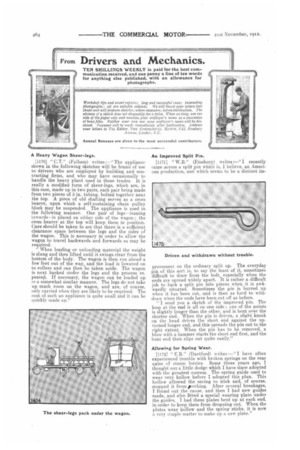A Heavy Wagon Sheer-legs.
Page 20

If you've noticed an error in this article please click here to report it so we can fix it.
[1170.1 " C.T." (Fulham) writes:—" The appliance shown in the following sketches will be found of use to drivers who are employed by building and contracting firms, and who may have occasionally to handle the heavy plant used in these trades. It is really a modified form of sheer-legs, which are, in this case, made up in two pairs, each pair being made from two pieces of 3 in. tubing, bolted together near the top. A piece of old shafting serves as a cross bearer, upon which a self-sustaining chain pulley block may be suspended. The appliance is used in the following manner. One pair of legs—leaning inwards—is placed on either side of the wagon ; the cross bearer at the top will keep them in position. Care should be taken to see that there is a sufficient clearance space between the legs and the sides of the wagon. This is necessary in order to allow the wagon to travel backwards and forwards as may be required.
"When loading or unloading material the weight is slung and then lifted until it swings clear from the bottom of the body. The wagon is then run ahead a few feet out of the way, and the load is lowered on to rollers and can then be taken aside. The wagon is next backed under the legs and the process re_ peated. If necessary, the wagon can be loaded up m a somewhat similar manner. The legs do not take up much room on the wagon, and are, of course, only carried when they are likely to be required. The cost of such an appliance is quite small and it can be quickly made up."






















